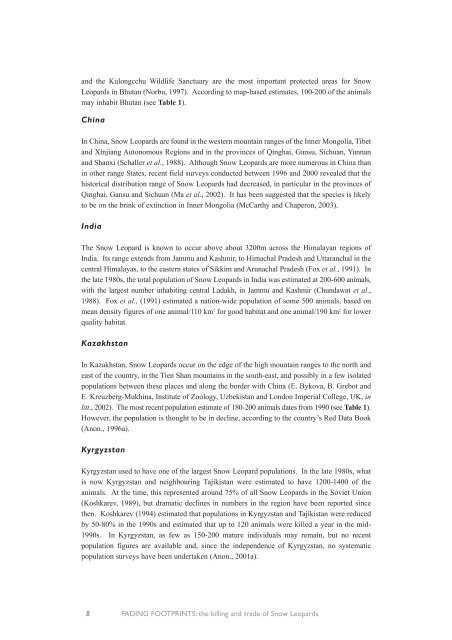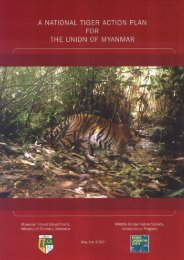Download - Global Tiger Initiative
Download - Global Tiger Initiative
Download - Global Tiger Initiative
Create successful ePaper yourself
Turn your PDF publications into a flip-book with our unique Google optimized e-Paper software.
and the Kulongcchu Wildlife Sanctuary are the most important protected areas for Snow<br />
Leopards in Bhutan (Norbu, 1997). According to map-based estimates, 100-200 of the animals<br />
may inhabit Bhutan (see Table 1).<br />
China<br />
In China, Snow Leopards are found in the western mountain ranges of the Inner Mongolia, Tibet<br />
and Xinjiang Autonomous Regions and in the provinces of Qinghai, Gansu, Sichuan, Yunnan<br />
and Shanxi (Schaller et al., 1988). Although Snow Leopards are more numerous in China than<br />
in other range States, recent field surveys conducted between 1996 and 2000 revealed that the<br />
historical distribution range of Snow Leopards had decreased, in particular in the provinces of<br />
Qinghai, Gansu and Sichuan (Ma et al., 2002). It has been suggested that the species is likely<br />
to be on the brink of extinction in Inner Mongolia (McCarthy and Chaperon, 2003).<br />
India<br />
The Snow Leopard is known to occur above about 3200m across the Himalayan regions of<br />
India. Its range extends from Jammu and Kashmir, to Himachal Pradesh and Uttaranchal in the<br />
central Himalayas, to the eastern states of Sikkim and Arunachal Pradesh (Fox et al., 1991). In<br />
the late 1980s, the total population of Snow Leopards in India was estimated at 200-600 animals,<br />
with the largest number inhabiting central Ladakh, in Jammu and Kashmir (Chundawat et al.,<br />
1988). Fox et al., (1991) estimated a nation-wide population of some 500 animals, based on<br />
mean density figures of one animal/110 km 2 for good habitat and one animal/190 km 2 for lower<br />
quality habitat.<br />
Kazakhstan<br />
In Kazakhstan, Snow Leopards occur on the edge of the high mountain ranges to the north and<br />
east of the country, in the Tien Shan mountains in the south-east, and possibly in a few isolated<br />
populations between these places and along the border with China (E. Bykova, B. Grebot and<br />
E. Kreuzberg-Mukhina, Institute of Zoology, Uzbekistan and London Imperial College, UK, in<br />
litt., 2002). The most recent population estimate of 180-200 animals dates from 1990 (see Table 1).<br />
However, the population is thought to be in decline, according to the country’s Red Data Book<br />
(Anon., 1996a).<br />
Kyrgyzstan<br />
Kyrgyzstan used to have one of the largest Snow Leopard populations. In the late 1980s, what<br />
is now Kyrgyzstan and neighbouring Tajikistan were estimated to have 1200-1400 of the<br />
animals. At the time, this represented around 75% of all Snow Leopards in the Soviet Union<br />
(Koshkarev, 1989), but dramatic declines in numbers in the region have been reported since<br />
then. Koshkarev (1994) estimated that populations in Kyrgyzstan and Tajikistan were reduced<br />
by 50-80% in the 1990s and estimated that up to 120 animals were killed a year in the mid-<br />
1990s. In Kyrgyzstan, as few as 150-200 mature individuals may remain, but no recent<br />
population figures are available and, since the independence of Kyrgyzstan, no systematic<br />
population surveys have been undertaken (Anon., 2001a).<br />
8 FADING FOOTPRINTS: the killing and trade of Snow Leopards

















